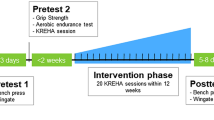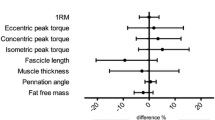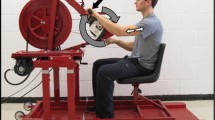Abstract
The purpose of this study was to determine if the protective adaptation to a single bout of eccentric exercise (repeated bout effect) is dependent on the muscle length at which the eccentric contractions are performed. Ten subjects (six men, four women) performed two bouts of 120 isokinetic eccentric contractions separated by 2 weeks (target intensity was 90% of maximum isometric strength at 70°). In the initial bout one limb exercised from 30° to 70° of knee flexion (short initial bout; SIB) and the contralateral limb exercised from 70° to 110° (long initial bout; LIB). For the repeated bout 2 weeks later, the limb that initially exercised at a short length now exercised at a long length (long repeated bout; LRB) and the limb that initially exercised at a long length now exercised at a short length (short repeated bout; SRB). Isometric strength and pain (scale 0–10) were assessed immediately post exercise and on the next 3 days. Strength loss and pain were greater following LIB versus SIB (strength loss P<0.01; pain P<0.001) and following LRB versus SRB (strength loss P<0.01; pain P<0.001). Strength loss and pain were not different between LIB and LRB. Pain was significantly greater following SIB compared with SRB (P<0.05). Strength loss was not different between SIB and SRB. These results confirm that the symptoms of muscle damage are highly dependent on exercising muscle length and also demonstrate that the repeated bout effect is dependent on muscle length. Performing an initial bout of eccentric exercise at a shortened muscle length did not protect against strength loss and pain following a repeated bout at a longer muscle length. Data are given as mean (SE) unless otherwise stated.






Similar content being viewed by others
References
Brockett CL, Morgan, DL, Proske U (2001) Human hamstring muscles adapt to eccentric exercise by changing optimum length. Med Sci Sports Exerc 33:783–790
Brooks SV, Zerba E, Faulkner JA (1995) Injury to muscle fibers after single stretches of passive and maximally stimulated muscles in mice. J Physiol (Lond) 488:459–469
Brown SJ, Child RB, Day SH, Donnelly AE (1997) Exercise-induced skeletal muscle damage and adaptation following repeated bouts of eccentric muscle contractions. J Sports Sci 15:215–222
Child RB, Saxton JM, Donnelly AE (1998) Comparison of eccentric knee extensor muscle actions at two muscle lengths on indices of damage and angle-specific force production in humans. J Sports Sci 16:301–308
Clarkson PM, Tremblay I (1988) Exercise-induced muscle damage, repair, and adaptation in humans. J Appl Physiol 65:1–6
Clarkson PM, Byrnes WC, Gillisson E, Harper E (1987) Adaptation to exercise-induced muscle damage. Clin Sci 73:383–386
Connolly DAJ, Reed BR, McHugh MP (2003) The repeated bout effect: a central or local mechanism? J Sports Sci Med 3:80–86
Hunter KD, Faulkner JA (1997) Pliometric contraction-induced injury of mouse skeletal muscle: effect of initial length. J Appl Physiol 82:278–283
Jones C, Allen T, Talbot J, Morgan DL, Proske U (1997) Changes in the mechanical properties of human and amphibian muscle after eccentric exercise. Eur J Appl Physiol 76:21–31
Koh TJ, Herzog W (1998) Eccentric training does not increase sarcomere number in rabbit dorsiflexor muscles. J Biomech 31:499–501
Lieber RL, Fridén J (1991). Muscle damage induced by eccentric contractions of 25% strain. J Appl Physiol 70:2498–2507
Lynn R, Morgan DL (1994) Decline running produces more sarcomeres in rat vastus intermedius muscle fibers than does incline running. J Appl Physiol 77:1439–1444
Lynn R, Talbot JA, Morgan DL (1998) Differences in rat skeletal muscles after incline and decline running. J Appl Physiol 85:98–104
McHugh MP (2003). Recent advances in the understanding of the repeated bout effect: the protective effect against muscle damage from a single bout of eccentric exercise. Scand J Med Sci Sports 13:88–97
McHugh MP, Tetro DT (2003) Changes in relationship between joint angle and torque production associated with the repeated bout effect. J Sports Sci 21:927–932
McHugh MP, Connolly DAJ, Eston RG, Gleim GW (2000) Electromyographic analysis of exercise resulting in symptoms of muscle damage. J Sport Sci 18:163–172
McHugh MP, Connolly DAJ, Eston RG, Gleim GW (2001) Electromyographic analysis of repeated bouts of eccentric exercise. J Sports Sci 19:163–170
Morgan DL (1990) New insights into the behavior of muscle during active lengthening. Biophys J 57:209–221
Newham DJ, Jones DA, Ghosh G, Aurora P (1988) Muscle fatigue and pain after eccentric contractions at long and short length. Clin Sci 74:553–557
Nosaka K, Clarkson PM (1995) Muscle damage following repeated bouts of high force eccentric exercise. Med Sci Sports Exerc 27:1263–1269
Nosaka K, Newton M (2002) Concentric or eccentric training effect on eccentric exercise-induced muscle damage. Med Sci Sports Exerc 34:63–69
Nosaka K, Sakamoto K, Newton M, Sacco P (2001a) How long does the protective effect on eccentric exercise-induced muscle damage last? Med Sci Sports Exerc 33:1490–1495
Nosaka K, Sakamoto K, Newton M, Sacco P (2001b) The repeated bout effect of reduced-load eccentric exercise on elbow flexor muscle damage. Eur J Appl Physiol 85:34–40
Saxton JM, Donnelly AE (1996) Length-specific impairment of skeletal muscle contractile function after eccentric muscle actions in man. Clin Sci 90:119–125
Warren GL, Ingalls CP, Lowe DA, Armstrong RB (2001) Excitation-contraction uncoupling: major role in contraction-induced muscle injury. Exerc Sport Sci Rev 29:82–87
Whitehead NP, Weerakkody NS, Gregory JE, Morgan DL, Proske U (2001) Changes in passive tension of muscle in humans and animals after eccentric exercise. J Physiol (Lond) 533:593–604
Wood SA, Morgan DL, Proske U (1993) Effects of repeated eccentric contractions on structure and mechanical properties of toad sartorius muscle. Am J Physiol 265:C792–C800
Author information
Authors and Affiliations
Corresponding author
Rights and permissions
About this article
Cite this article
McHugh, M.P., Pasiakos, S. The role of exercising muscle length in the protective adaptation to a single bout of eccentric exercise. Eur J Appl Physiol 93, 286–293 (2004). https://doi.org/10.1007/s00421-004-1196-0
Accepted:
Published:
Issue Date:
DOI: https://doi.org/10.1007/s00421-004-1196-0




